
By Angelo Randaci, Earth’s Ally Horticulturist
Angelo’s passion for plants has led him to explore many areas of horticulture including research, grounds management, technical training, design and nursery management.
Angelo’s Favorite Throwback Plants
A Brief History of Houseplants
In the 1970s, houseplants were a craze. They experienced a decorative revival fashioned off the lavish lifestyle of the Roaring 1920s. But houseplants used as home accents can be traced all the way back to the Greek, Roman and even Egyptian eras when families decorated their homes and courtyards with specimens gathered from the local fields and woods. It was during the 1800s that an English doctor and amateur horticulturist, Dr. Nathaniel Bagshaw Ward made
a discovery. He discovered that plants enclosed in a sealed glass case would be protected against this toxic environment. His glass case would also allow plants to survive for long periods of time without water. As a result, plant explorers could collect plant specimens from exotic locations around the world. Plant enthusiasts would bring these new plants into their gardens, into the conservatories and into their homes. They were called Wardian cases but are now known as terrariums.
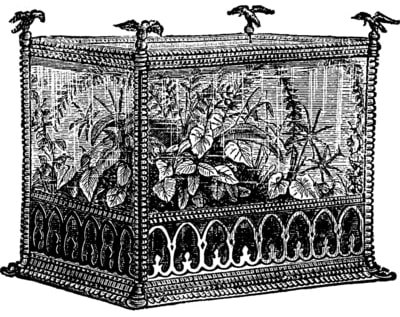
By the 1960’s a new movement began after the publishing of Racheal Carlson’s New York Times best seller Silent Spring in 1962. Her book raised public awareness about the degradation happening through our chemical farming and gardening practices. In 1970s the first Earth Day was born which further encouraged a rise in environmental awareness.
With all the environmental awareness stirring underneath the societal surface many people turned to a stunning selection of their favorite vintage plants to regenerate their nature connection within both their outdoor and indoor living areas. Outdoors, elaborate perennial gardens beautified their yards. Indoors, homes were decorated with an array of indoor plants either hanging near windows or sitting atop the kitchen table. Vintage garden plants have stood the test of time. This list is just a few of my favorite vintage indoor plants.
6 Throwback Houseplants
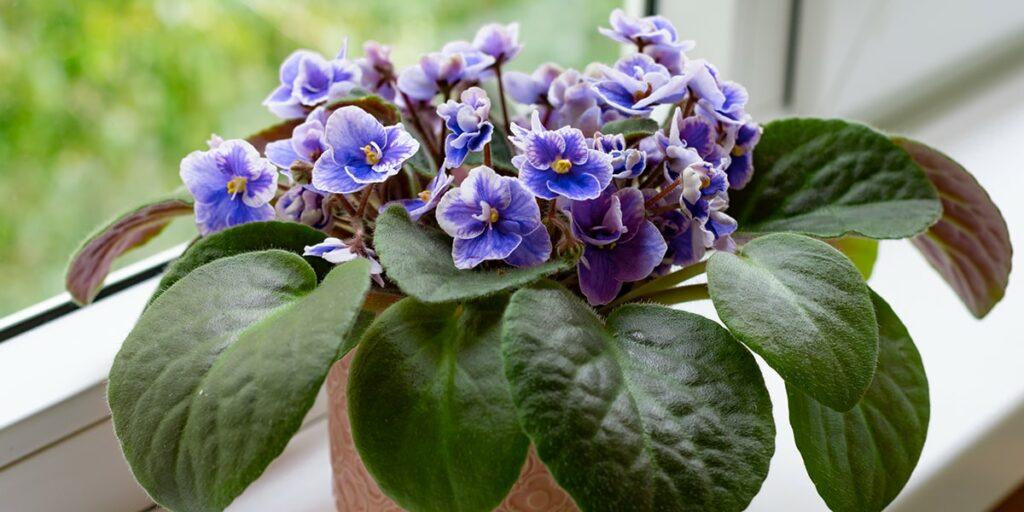
African Violet (Saintpaulia ionantha)
Non-toxic to children and pets
African violets were one of those long ago collected varieties that became a favorite plant for a time during the ’70s. Their petite purple, pink and red bell-shaped flowers on tiny compact plants were irresistible. African violets, although having a reputation for being a bit fussy, became a collectors delight with the resurgence of the Wardian case and were one of the most popular houseplants throughout the ’70s. They remain one of the world’s most popular and beautiful houseplants today. Their delicate flowers symbolize feminine energy, adding joy and love to your home. When properly cared for they are easy houseplants that flower all year long, given bright light, in warm humid conditions and are especially suited to growing under lights. Water with room-temperature water because cold water shocks the roots and causes leaf spots. Avoid getting water on the leaves. Repot as necessary in a well-draining African violet potting mix. Fertilize with an African violet fertilizer following label recommendations. Cyclamen mites and mealybugs are the most common pests.

Cape Primrose (Streptocarpus sp.)
Non-toxic to children and pets
Another member of the African Violet family is Streptocarpus. The name Streptocarpus is derived from the Greek word streptos, describing the twisted seed capsule. Carpus simply means fruit. The most popular common name is Cape Primrose, taken from its origins in the Cape region of South Africa. Cape Primroses display a dazzling array of flowers on sturdy stems, borne well above the leathery elongated leaves. Prior to the 1970s the main flower colors were blue and white, but in 1972, seven new varieties were introduced bringing new colors of reds, magenta, purples and pinks.
Cape Primrose growing requirements are similar to African violets, but not as challenging. Grow them in an organic potting mix formulated for African violets. This mix will encourage healthy foliage as well as beautiful blooms. Position them in an area receiving bright light but never in full sun because the foliage can easily be damaged. Temperatures around 70°F are ideal. Fertilize with a weak solution of African violet fertilizer during periods of active growth but feed regularly to maintain a steady supply of nutrients. Allow your plants to dry out slightly before watering to avoid root rot and never let them sit in water. Aphids and mealybugs are the main insect pests.
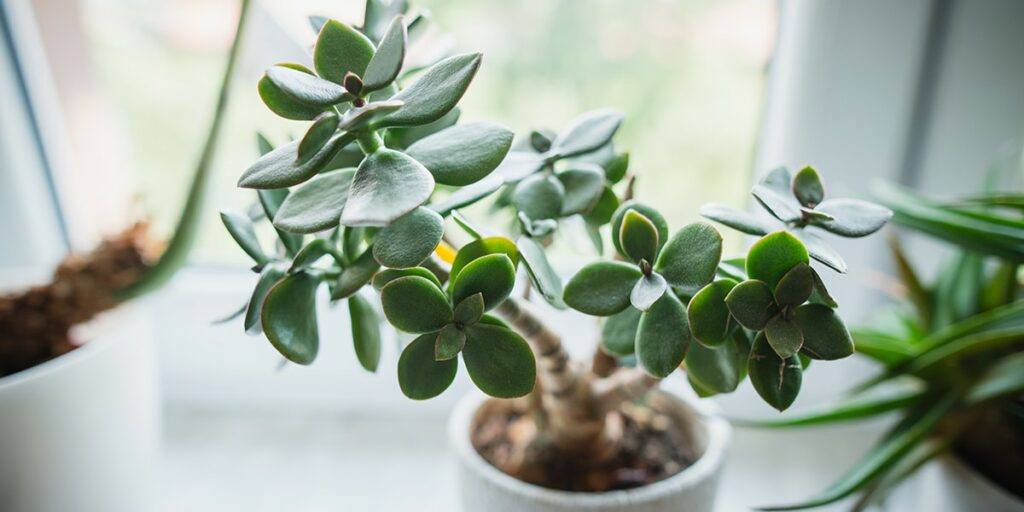
Jade Plant (Crassula ovata)
Mildly toxic to children but extremely toxic to pets
Jade plants were trendy during the 1970s and were one of the most popular houseplants grown. Also known as money plants, people considered them good luck, bringing wealth, prosperity, and good fortune. You don’t need luck or good fortune to grow jade plants though and by following a few simple guidelines, the same guidelines for growing most succulents, your jade plant will thrive for many years.
Jade plants require bright, natural sunlight to flourish. In low light situations they grow spindly, stretching for the sunlight. Jade plants, like other succulents, store water in their stems and leaves. For this reason, they can survive for long periods without water and may only need water once every couple of weeks during summer and even less during winter months. Mealybugs and scale pests often hide under leaves and stems. Earth’s Ally Insect Control is a safe and effective spray for treatment when these pests pop up.

Spider Plant (Chlorophytum comosum)
Non-toxic to children and pets
The 1970s also spawned a new fad of macramé plant hangers and spider plants were their main recipients because of the lovely little sports grown at the ends of cascading foliage. The hangers cradled the plants beautifully and enhanced the tumbling foliage, each stem carrying a baby “spider” at the tip. They thrived on very little attention hanging from ceilings and rafters of homes and businesses. It is said this plant brings abundance into the home and serves as a symbol of renewal as well as making connections with others. Spider plants are one of the most adaptable houseplants and will grow in many varied environments around your home with minimal care. Provide them with a well-drained potting mix and an area receiving bright, indirect light. Allow them to dry out slightly between watering periods and never let them sit in water. Spider plants are sensitive to fluoride and chlorine in tap water, which may cause browning of the leaf tips. Avoid this issue by watering with rainwater, filtered or distilled water. A few common pests of spider plants are aphids, whiteflies, and spider mites.
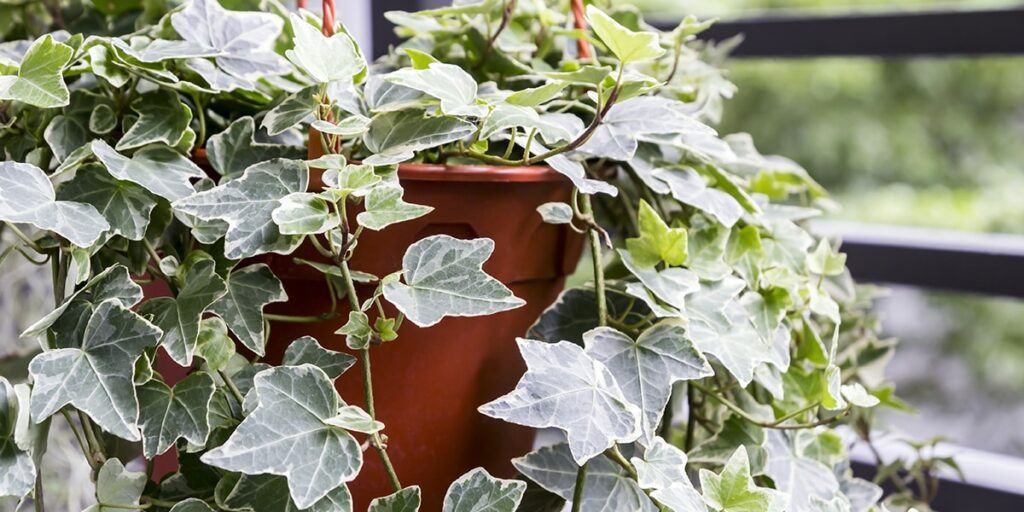
English Ivy (Hedera helix)
Toxic to children and pets
In 1989, ivy sales increased when NASA listed English Ivy as an air purifier to absorb formaldehyde and was reputed to reduce airborne molds by up to 94%. But English ivy was popular long before that as part of the houseplant craze during the ’70s. There were many favorite varieties and different forms climbing indiscriminately throughout many homes. English Ivy is a symbol of devoted attachment, dedication and affection towards partners or friends. Ivy wreaths were given to married couples as a symbol of fidelity as well as symbolizing faithfulness between people bound by trust and duty. Having one in your home meant prosperity. They were sold in most nurseries and even hospital gift shops where they were given as gifts to cheer up patients. They tolerate low light, but a bright light out of direct sun will assure vibrant growth. Avoid overwatering as this will cause root rot. The main pests of English ivy are spider mites and mealybugs which will thrive in the warm, dry, home environment.
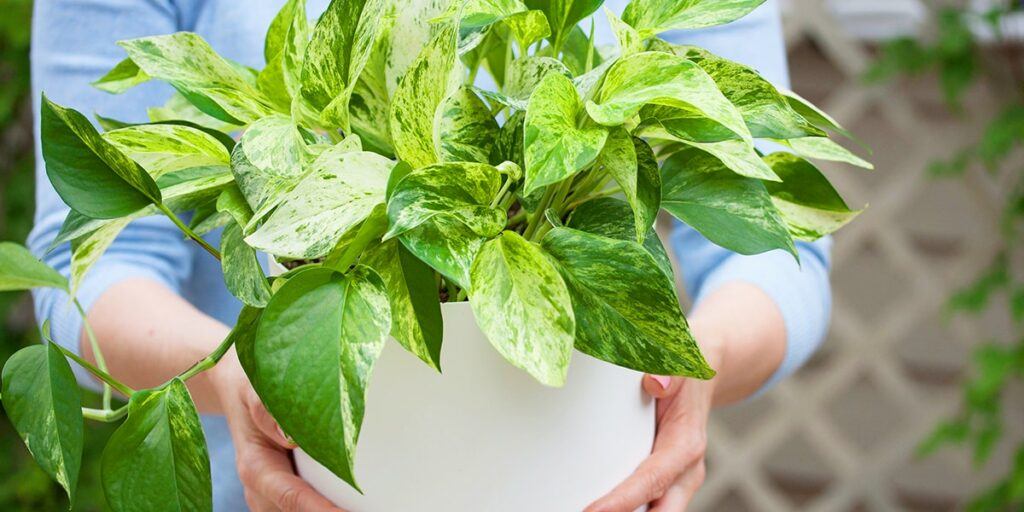
Devil’s Ivy (Epipremnum aureum)
Toxic to children and pets
Pothos is known as a lucky plant which will bring its owner wealth and good fortune. I’ve seen them hanging from the ceiling in one of Sarasota’s local coffee shops where a half dozen or so plants are suspended in hanging pots. Pothos is as common now as it was back then. It is still widely used in homes as well as business establishments for good reason. It is one of the easiest plants to grow tolerating low light, humidity, and even a touch of neglect for periods of time. Grow them in any well-drained potting soil. Allow them to dry out a bit between watering cycles. Mealybugs, spider mites and scales are common pests of this plant.
Vintage Houseplants Worthy of Honorable Mention
This is just a small list of the many types of houseplants still well-worthy of home and office.
- Prayer Plant (Maranta leuconeura)
- Hoya (Hoya sp.)
- Boston Ferns and others
- Begonias; Rex Begonia, Tuberous Begonias and others
- Pepperomias
- Sansievierias
- Goldfish Plant (Columnea gloriosa)
- Grape Ivy (Cissus rhombifolia)
- Swiss Cheese Plant (Monstera adansonii)
- Tradescantia sp.
- Pregnant Onion (Ornithogalum lonibracteatum)
- Dracaena sp.
- And many more…
Retro Houseplant Tips
While this list contains just a few of the most popular plants during the 1970s, many new varieties exist today. Look for new colors and forms of your favorite oldies. Explore the many types of plants.
- Wherever you see healthy houseplants growing, observe the conditions in which they grow. It will give you a good idea of where your plant would be happy.
- Put your plants outside during warm summer months (out of direct sunlight). Remember that houseplants are happiest outdoors where they belong.
- Chopsticks work well for tamping soil around smaller pots when repotting. Save your chopsticks after eating at your favorite oriental restaurant.
- Do not fertilize your plants when the soil is dry as this may cause damage to roots and leaves. Water your plants first with plain water, then follow up with a feeding.
- Growing houseplants under lights makes a great hobby. Flowering plants such as African Violets and Cape Primroses will reward you with flowers all winter long.
- When planting more than one species of plants together in the same pot, make sure they share the same cultural requirements.
- Improving your indoor air circulation will keep diseases and insect pests to a minimum. Humidity is best increased by a humidifier. It is better for your health as well.
- Inspect plants before you purchase for insects or disease. Inspect your houseplants regularly as well. A magnifying lens and preventative applications of Earth’s Ally Insect and Disease Control will make the job much easier.
- Complete growing instructions are not given here. Research the plants you wish to add to your collection before you buy.
- Avoid softened water, which is too salty and may damage your plants.
We’d love to hear how Earth’s Ally is helping you grow healthy houseplants! Share your experience and stay connected with the #EarthsAlly community on Facebook, Instagram and Twitter for access to our latest blog posts, giveaways and exclusive promotions.
